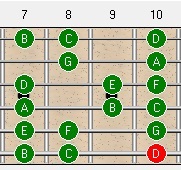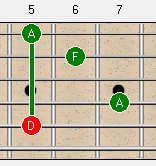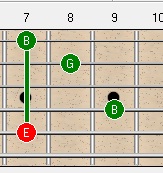 Dorian Mode For Guitar
Dorian Mode For Guitar
Hey everyone, been a while but I have some time this week so I have made up a little lesson on modes and mainly dorian mode.
If you remember from my past lessons, a major scale is made up of specific intervals.
These intervals are as follows: WWHWWWH
The reason the major scale sounds the way it does is because of these intervals.
If we start our major scale from a different note, say the second note of the scale, then the interval pattern would look like this: WHWWWHW
We have a name for that interval pattern and it is called dorian mode.
See diagram (click to enlarge):
Memorize this scale, get familiar with how it sounds. Make sure you start on the red note, it is the root.
We are going to play a bit in D dorian mode and learn how to write a progression to get the sound of dorian mode.
I want to clear up some misconceptions. I have had students in the past ask me whether they can play any mode over any song. The answer is no. Modes are decided by the chords they are played over. If I have a progression that goes 1 bar on a C major chord and one bar on F major and you want to play G mixolydian over it, it will not sound like G mixo no matter what you do.
Modal music is what is called static. In other words the harmony stays in one place.
If you want the sound of a mode you have to use the chord that is the parent of that mode and little else.
Example in the key of C:
Cmaj7 – Ionian mode
Dm7 – Dorian mode
Em7 – Phrygian mode
Fmaj7 – Lydian mode
Gmaj7 – Mixolydian mode
Am7 – Aeolian mode
Bm7b5 – Locrian mode
Now if you know your trusty C major scale (we have been over them in past lessons) you will be able to play all 7 modes. But how does that work?
Well, if you record Dm and then play C major scale over it, what your ear will hear is not C major but rather D dorian as the static quality of hitting that one chord causes your ear to hear that as the dominant key center. Make sense? Same with any chord in C with C major scale played over top. Play C major scale over Em7 your ear hears E Phrygian mode, play C major scale over F maj7 you will hear F Lydian mode and so on.
Now, strumming Dm over and over is monotonous so you can actually use more chords. You just have to make sure that you make Dm7 a major component of your static dorian progression (use it more than any other chord). You will need to use only chords from the key you are in. D dorian is in the key of C major so any chords from C major could be used in conjunction with the chord that goes with D dorian. The other chords in C major I listed above.
Here are some other examples:
Dm7 to Bm7b5, Dm to G7, Dm to Cmaj7 are all fine static progressions that work well with dorian in the key of Cmajor. You need to play Dm7 in the first bar then somwhere in the second bar do the other chord but always come back to the Dm7 by the 3rd bar, this keeps the progression static. Other chords can be used but I like to make sure that the second chord I use besides Dm7 has notes that are going to show off this mode’s particular hallmarks. Dorian has a b3 (F) and a major 6 (B) which make it stand out, so chords with B and F in them pronouce the tonality of the mode more.
A great example of dorian mode is found in the Miles Davis tune So What. Look it up. The first 16 bars are in D dorian mode. Chords are basically Dm7 to Em7.
Here are the Dm7 and Em7 chords and the tab showing you the rhythms for how to play it (click to enlarge):
So there you have the rhythm. Record that and then play your D dorian mode over and have a listen to the difference in sound of that vs when you play a C major scale without chords behind it.
Below I have recorded a bit of myself jamming over D dorian then a little demo of me playing D dorian mode with no rhythm behind me. It is harder to get the sound of a mode if you do not know the important notes that make up a mode. In dorian the important notes are 1, b3, 5, and 6 or D, F, A and B. The b3 and major 6th in particular define the sound of this mode. I land a lot on those two notes when I improvise in that mode, makes the sound of the mode clearer.
I also have a section in the vid where I show you how to play a D dorian rhythm then a spot where we can trade 4 bars each improvising over that rhythm if you are feeling more comfortable with the scale.
Here is the vid:
Enjoy!



